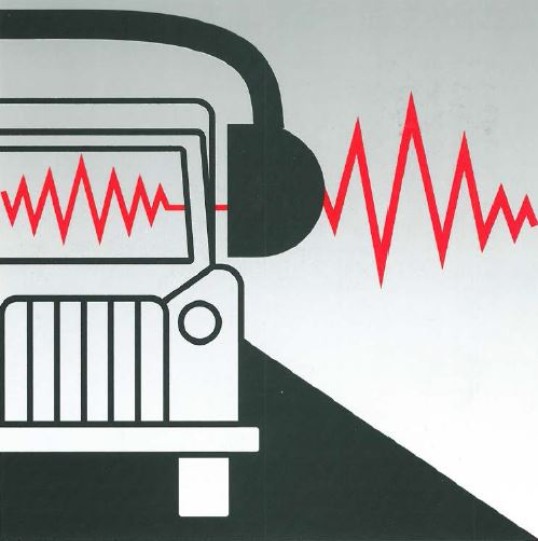- Artificial Intelligence (AI)
- Occupational exposure limit values
- Climate Change and Occupational Safety
- List of CMR substances
- Electromagnetic fields
- Ergonomics
- EU GHS Regulation
- Industrial Security
- Collaborative robots
- Noise
- Nanoparticles at the workplace
- Optische Strahlung
- REACH
- Reference materials
- Proficiency testing
- Vibration
- Virtual reality
- Work 4.0
Signal audibility for wearers of hearing protectors

Drivers in the public traffic are subject to special requirements for hearing protection.
Source: DGUV (part of the cover of BIA Report 5/97)
Users of hearing protectors at workplaces may need to be able to hear signals from the work environment. Essential criteria for selection of a hearing protector suitable for such cases are the audibility of warning signals and informative sounds in the work environment, and the intelligibility of speech at the workplace. The IFA list of approved products (list of all hearing protectors with EC/EU type examination certification that have been reported) assists in selection by stating supplementary codes indicating the signal audibility. The codes are determined by the IFA from the mean values for the sound attenuation measured during the type examination of the hearing protectors.
The significance of the codes is as follows:
- W: The test criteria of "audibility of warning signals in general", "sounds containing information" and "speech intelligibility" are satisfied. The mean slope of the mean values for the octave band sound attenuation does not exceed 3.6 dB/octave.
- X: Hearing protector with an extremely flat attenuation curve. This is suitable for persons with impaired hearing, and may also be suitable for musicians. The mean slope of the mean values for the octave band sound attenuation does not exceed 2 dB/octave. A flat attenuation curve means that the rise in sound attenuation from low to high frequencies is low. The greater the difference in sound attenuation between the different frequency ranges, the greater the change in perceived hearing compared to the unprotected ear. This can cause problems during demanding hearing tasks such as the recognition of signals or for particular groups of persons, such as musicians. For this reason, a hearing protector with a frequency-independent sound attenuation characteristic (code W, or better still code X) should be selected in such cases.
- S: Signals are audible during work on the track superstructure.
- V: Signals are audible for drivers of vehicles on public roads.
- E1, E2 and E3: Signals are audible for train drivers and shunting engine/train drivers in railway operations in the following qualities: E1 = very suitable, E2 = suitable, E3 = partly suitable.
The codes W and X take account only of the sound attenuation values of the hearing protectors. Hearing protectors marked in this way are therefore suitable for the majority of workplaces. The three other codes, i.e. S, V and Ex (x = 1 to 3), also consider the spectra of signals and background noises at the specific workplaces stated. The surveillance authorities in Germany impose particular requirements upon the signal audibility when hearing protectors are used in these three areas of work. These requirements are met when a suitably marked hearing protector is selected and its suitability for use at the workplace can be demonstrated by means of a personal hearing test. Procedures for the hearing test can be found in the publications of the accident insurance institutions concerning the relevant areas of work.
The IFA has issued a number of publications on signal audibility. An overview (PDF, 61 kB, non-accessible) is available containing links to the abstracts and in some cases to the full texts.
A list of approved hearing protectors suitable for use in railway operations (by train drivers and shunting engine/train drivers) bearing the code Ex is available for download.
A web application can be used to obtain a prognosis of the perceptibility of warning signals for a hearing protector (codes W, X, S, V and Ex in the IFA's list of approved products). The prognosis is based upon sound attenuation values from the type examination of the hearing protector.

